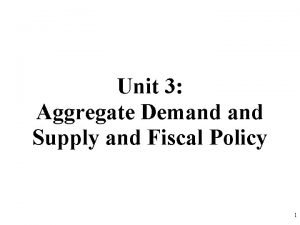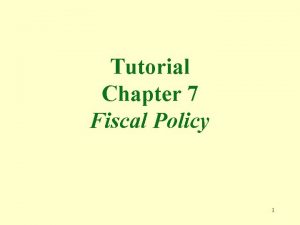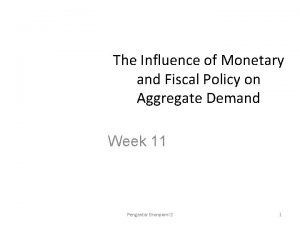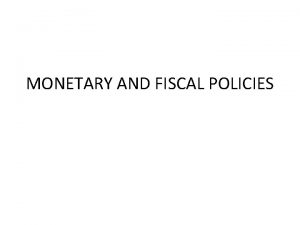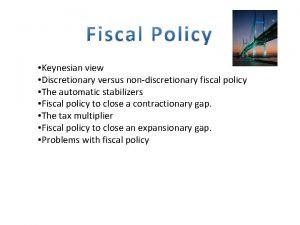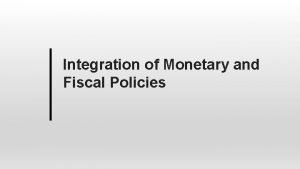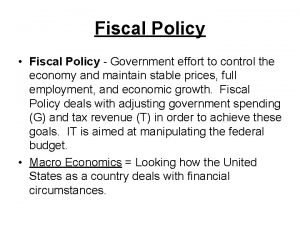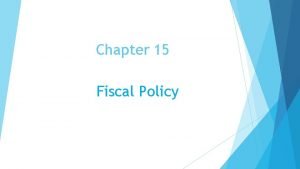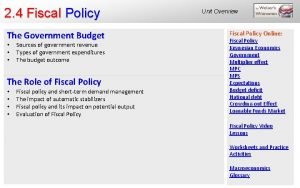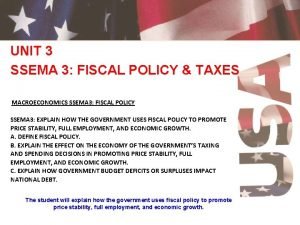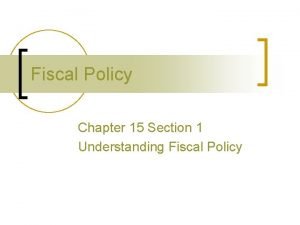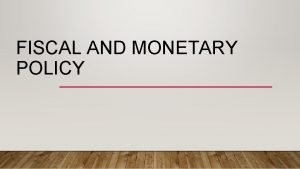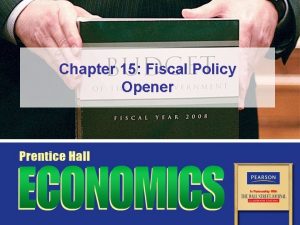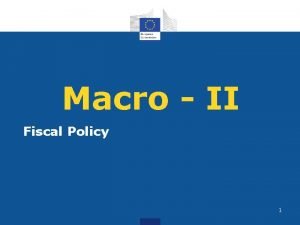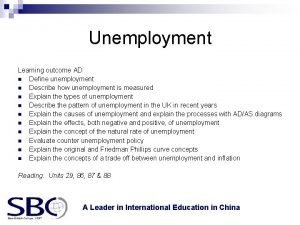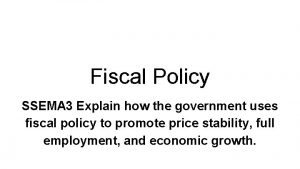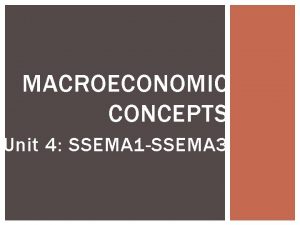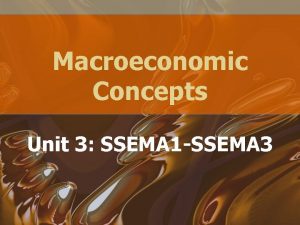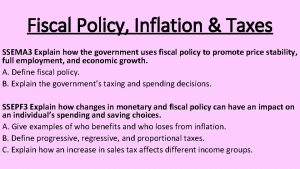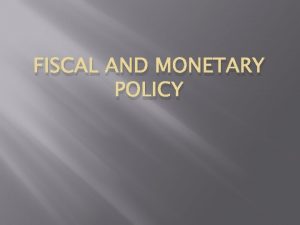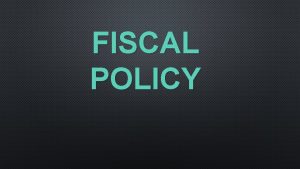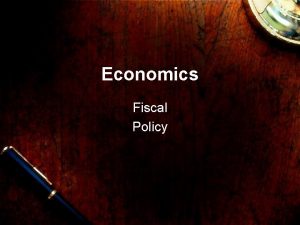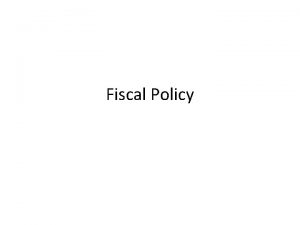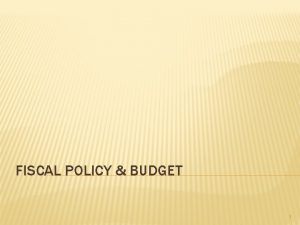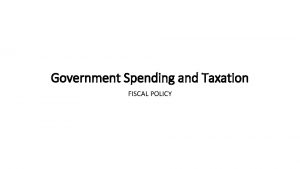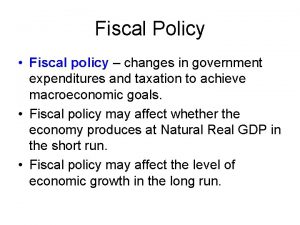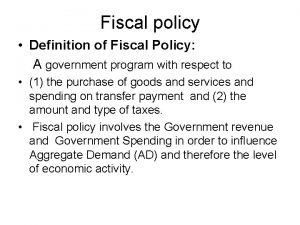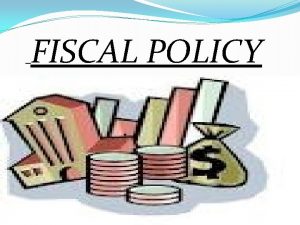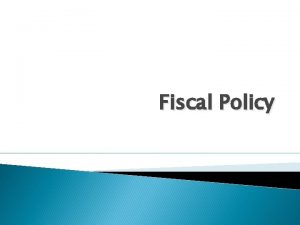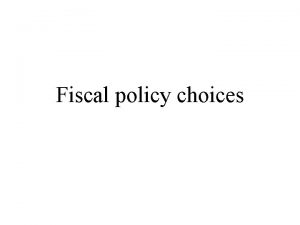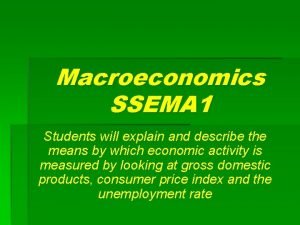Fiscal Policy SSEMA 3 Explain How the Government




























- Slides: 28

Fiscal Policy

SSEMA 3: Explain How the Government uses Fiscal Policy to promote price stability, full employment, and economic Growth Goal: For you to be able to explain how Congress and the President work together to achieve the Three goal of Macro Econ. For you to be able to explain how the government responds to the different stages of the business cycle.

SSEMA 3. a Define Fiscal Policy

Fiscal Policy The federal government’s decisions it makes about taxing and spending in order to promote economic growth and stability

Any form of money the gov’t takes in or spend falls under the fiscal policy umbrella How does the Government Spend money? How does the Government take in money?

SSEMA 3. b Explain the effect on the economy of the government’s taxing and spending decisions in promoting price stability. Full employment, and economic growth

Taxing & Spending Decisions

Taxes- Revenue the government creates from individuals’ working wages.

Government Spending

Government Spending – Did You Know? Federal Government Current Expenditures ($billions, nominal annual values for years shown) $4, 000 Spending • Like households and firms, the federal government is also a consumer of goods and services $3, 487 $3, 500 $3, 000 $2, 500 $1, 839 $2, 000 Facts • The BEA reports nominal values of federal government expenditures on an annual and quarterly basis • The measure of government spending shown to the right is part of NIPA (National Income and Product Accounts) Table 3. 16, which is published by the Bureau of Economic Analysis (BEA) $1, 500 $1, 000 $532 $1, 199 $500 $0 1980 1990 2000 2010 Source: Bureau of Economic Analysis Relationship • The sheer size of federal government spending makes government expenditures a major component of U. S. gross domestic product (GDP) Note: See Power. Point file for references Data. Post Nominal government spending has grown over time. Its value in 2000 was more than triple that in 1980. www. frbsf. org/education/teacher-resources/datapost FRBSF Education & Outreach

Government Spending by Function 2005 vs. 2015 ($billions, nominal annual values) $4, 500 Income Security $4, 000 $3, 500 $1, 344 Health Together, income security and national defense account for almost 50% of all federal spending. National Defense $3, 000 $2, 500 $816 $1, 163 $2, 000 $593 Other $477 $1, 000 $423 $132 $500 $542 $152 $107 $122 $67 Nominal spending on health increased 93% between 2005 and 2015. Education $602 $1, 500 General Public Service Economic Affairs Overall, nominal federal spending increased 54% between 2005 and 2015. $91 $0 2005 2015 Source: Bureau of Economic Analysis Data. Post www. frbsf. org/education/teacher-resources/datapost FRBSF Education & Outreach

Federal Government Current Expenditures Nominal annual values ($billions) through 2015 $4, 500 $4, 000 $3, 500 $3, 000 $2, 500 $2, 000 $1, 500 $1, 000 $500 $0 1955 1960 1965 1970 1975 1980 1985 1990 1995 2000 2005 2010 2015 Source: Bureau of Economic Analysis Data. Post www. frbsf. org/education/teacher-resources/datapost FRBSF Education & Outreach

What Do You Think? 1. In general, how did spending on education in 2005 compare to 2015? (See slide 3) 2. What was total government spending in 2005? In 2015? (See slide 3) 3. What percentage of federal spending went to education in 2005? In 2015? (See slide 3) 4. What was the largest category of government spending in 2005? In 2015? (See slide 3) Data. Post www. frbsf. org/education/teacher-resources/datapost FRBSF Education & Outreach

When does the gov’t spend money?

Increasing Price Level Contractionary Fiscal Policy Curb Inflation 1. Lower government spending 2. Increase Taxes These policies take money out of the economy. Fewer Firms earning money from the Gov’t contracts Lowers Consumption & Investment spending Eventually reducing inflation

Promoting Full Employment & Economic Growth when Price Level is not a concern. The government uses tools designed to increase consumption and investment spending in an economy. Lowering taxes allows people to keep more of their income for spending on goods and service Increasing Government spending, more firms and workers can earn money from government contracts and jobs Household spend some of this additional income on goods and services, increasing economic activity.

TOGETHER: MONETARY AND FISCAL POLICY TOGETHER The Federal Reserve and Congress Both want to correct the economy the best combination in achieving this goal is through increasing government spending, sell treasure bonds, but taxes, and buy treasury bonds.


SSEMA 3. C Explain how government budget Deficits or surpluses impact national Debt

Budget Includes sources of income (Taxes & Fees) and List of Expenses

Expenses Include all the public goods and services provided by the government as well as the interest payments the government pay on its debt Total amount of Income – (Minus) the total number of expenses

Government Surplus Exist when the amount of income (Taxes and Fees) received exceeds the amount of expenses paid.

Government Deficit Exist when the amount of income received falls short of the amount of expenses paid.

National Debt Each time the government borrows money it adds to the national debt, the total amount of money owed by the federal government. Is the sum of all past deficits plus interest.

Deficit Spending Occurs when the government spends more money than it collects in revenue. To finance spending, governments often borrow money by selling bonds.

Debt Clock http: //www. usdebtclock. org/

https: //www. econedlink. org/tool/199/Budget-Deficits-Public-Debt-Video-Quiz

How does Monetary and Fiscal policy work together to achieve a sound Economy?
 Ssema
Ssema Inflation
Inflation Example fiscal policy
Example fiscal policy Fiscal policy practice
Fiscal policy practice Components of fiscal policy
Components of fiscal policy Crowding out effect of fiscal policy
Crowding out effect of fiscal policy Contractionary fiscal policy interest rate
Contractionary fiscal policy interest rate What is liquidity ratio in banking
What is liquidity ratio in banking Non-discretionary fiscal policy
Non-discretionary fiscal policy Instruments of fiscal policy
Instruments of fiscal policy Fiscal policy ib definition
Fiscal policy ib definition Fiscal demand side policy
Fiscal demand side policy Fiscal policy to control inflation
Fiscal policy to control inflation Contractionary fiscal policy
Contractionary fiscal policy Instruments of fiscal policy
Instruments of fiscal policy Crowding out
Crowding out Demand side fiscal policy definition
Demand side fiscal policy definition Contractionary fiscal policy interest rate
Contractionary fiscal policy interest rate Crowding out effect of fiscal policy
Crowding out effect of fiscal policy Example of expansionary fiscal policy
Example of expansionary fiscal policy Fiscal policy
Fiscal policy Goals of fiscal policy
Goals of fiscal policy Fiscal vs monetary policy
Fiscal vs monetary policy Goals of fiscal policy
Goals of fiscal policy Fiscal policy
Fiscal policy Unit 3 aggregate demand aggregate supply and fiscal policy
Unit 3 aggregate demand aggregate supply and fiscal policy Tax multiplier formula
Tax multiplier formula Unemployment diagram
Unemployment diagram Fiscal policy in macroeconomics
Fiscal policy in macroeconomics


